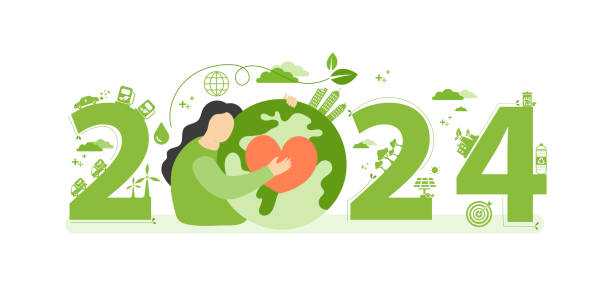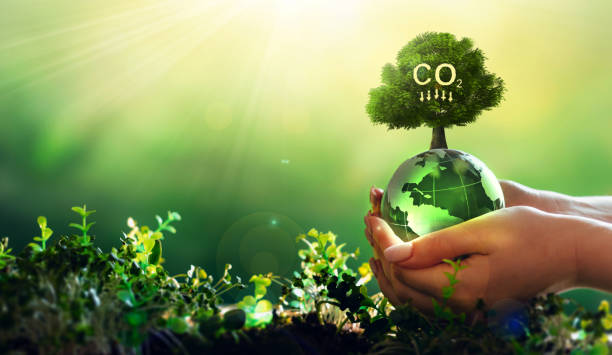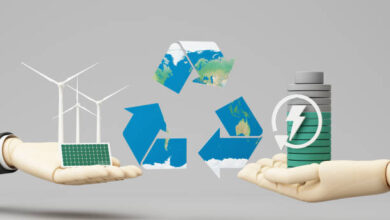
As climate change continues to threaten our planet, the need for a more sustainable and environmentally-friendly economy has become increasingly urgent. In recent years, there has been a growing movement towards a “green economy” – one that prioritizes the use of renewable resources and minimizes harmful emissions. Not only does this shift benefit the environment, but it also presents numerous economic opportunities. In this blog post, we will explore the concept of a green economy and discuss the various ways in which it can benefit both the planet and our wallets. From carbon to cash, let’s delve into the promising future of a green economy.
Understanding the Concept of a Green Economy
Imagine an economic model where the environment isn’t just an afterthought, but the center of all considerations. That’s the premise of a green economy, a bold and progressive framework that treasures our natural capital. The green economy harmonizes economic advancement with ecological sustainability, all with an overarching aim of safeguarding our planet’s precious resources.
It’s about flipping the script on how we traditionally do business. In this innovative model, we bid farewell to industries heavy on carbon emissions, making a clean break from an economy that thrives on fossil fuels. Instead, we wholeheartedly embrace sustainable practices that are kinder to the planet.
In essence, the green economy offers a vision of a future where our economic goals and environmental responsibilities are not at odds. Instead, they can work in synergy to create a sustainable and prosperous future for all. It’s an exciting journey that requires a significant paradigm shift, but the rewards, for our planet and our economies, are beyond measure.
The Potential of Renewable Energy and Green
In a world where the resources we’ve long depended on are rapidly depleting, renewable energy swoops in like a shining knight on a solar-powered steed. The cornerstone of a green economy, renewable energy, with its vast array of options like wind, solar, and hydro, embodies unlimited possibilities and a fresh approach to meeting our energy needs. Unlike oil, coal, and gas, renewable energy sources are enduring, capable of replenishing themselves. The beauty of renewable energy lies not just in its sustainability but also in its minimal environmental footprint.
Investing in renewable energy is akin to betting on a champion racehorse. Not only does it pay off handsomely in the long run, it also serves the higher purpose of safeguarding our planet. A commitment to renewable energy signifies a step away from harmful emissions and a stride towards a cleaner, greener world. And here’s the best part – this is a race where everyone wins. Our planet gets to breathe a little easier, and we secure a sustainable, dependable energy system that fuels the green economy’s momentum.
But let’s not forget, renewable energy doesn’t just light up our homes and power our industries. It also ignites opportunities. As the green economy catches on, we can expect an upswing in demand for renewable energy, which could spark a wave of innovation, stimulate job growth and give a boost to local economies.
While the journey to a green economy may be paved with challenges, it’s the bright beacon of renewable energy that will guide us on this exciting new path. It’s a path where every turn we take and every decision we make can contribute to a future where our economic ambitions and ecological responsibilities walk hand in hand. This isn’t just a possibility. It’s a potential we can harness today, for a brighter, greener tomorrow.

Economic Growth and Job Creation in the Green Economy
When we talk about a green economy, we’re not just talking about a grand scheme to save Mother Earth. This shift also brings with it the promise of substantial economic rewards.
Transitioning to a green economy can stimulate a new wave of economic growth and generate countless job opportunities. It’s like setting off a domino effect – once we start tipping towards green industries, such as renewable energy, waste management, and green construction, we unlock a cascade of jobs.
Picture this: a new workforce dedicated to installing solar panels, maintaining wind turbines, constructing energy-efficient buildings, or innovating waste management solutions. These aren’t just any jobs. These are meaningful, future-oriented careers that make a tangible difference. These are roles in sectors that are growing, not declining, presenting opportunities for long-term stability and development.
The beauty of this growth is that it doesn’t just boost the economy. It does so while actively reducing carbon emissions. It’s a win-win situation that turns the idea of ‘sacrifice for the environment’ on its head. We aren’t just working towards the preservation of our planet; we are also paving the way for an era of green prosperity.
While we strive to keep our environment clean, let’s remember that a green economy is also about keeping the engine of our economy purring. Transitioning towards sustainability doesn’t mean stifling growth; instead, it means redirecting it towards sectors that promote wellbeing for our planet and its inhabitants.
And so, in this new world order of the green economy, job creation and economic growth find themselves happily hitched to environmental conservation. What an exciting prospect for our future generations to inherit – a world where the economy and ecology march forward hand in hand!
Investing in Green Economy, Infrastructure and Technologies
Pouring capital into the green economy, as well as sustainable infrastructure and technology, is like planting seeds of prosperity. Green investments offer a compelling narrative of economic resilience and a potent solution to our environmental predicament. Companies are fast realizing that the road to long-term profitability and stability is painted green. It’s not just about being environmentally friendly; it’s about future-proofing businesses.
Think about it, every dollar invested in green technologies, be it a state-of-the-art recycling facility or a cutting-edge wind turbine, pushes us a step closer to a sustainable future. Each investment fuels the engine of the green economy, accelerating the shift towards a sustainable and profitable world.
The green investment portfolio is diverse, spanning renewable energy technologies, energy-efficient appliances, electric vehicles, and much more. It’s a dynamic landscape that is constantly evolving, driven by innovation and creativity. Each sector presents an opportunity to reduce our carbon footprint and champion sustainable practices, all while ensuring solid returns on investment.
Infrastructure, too, plays a vital role in this green narrative. Imagine streets lit by energy-efficient LED lights, or buildings constructed with energy-saving materials. Imagine public transport powered by clean energy, reducing our reliance on fossil fuels. This is what investing in green infrastructure looks like – it’s about creating sustainable urban landscapes that are not only functional and efficient but also kind to our planet.
Importantly, green investments are not just beneficial for the environment; they are good for business too. Companies making the shift to sustainable practices often find themselves on a more stable and secure financial footing. With consumers becoming increasingly conscious about the environmental impact of their purchases, businesses that can demonstrate a genuine commitment to sustainability have a distinct competitive edge.
Overall, investing in the green economy, its infrastructure, and technologies is an exciting frontier for businesses and investors alike. It’s a journey that offers a double reward – a healthier planet, and a healthier bottom line. The road to a green economy may be uncharted, but with every green investment, we are carving out a path to a future that is sustainable, profitable, and ultimately, greener.

The Role of Government Policy in Promoting a Green Economy
Let’s turn our attention to the major players on the green stage – the governments. As we tread on the path of sustainability, the role of government policies becomes increasingly critical. These policy mavens hold the keys to encouraging and facilitating the transition towards a green economy. But how, you may ask?
Through the magic wand of legislation, of course. By establishing robust regulatory frameworks, governments can lay a solid foundation for a green economy. For instance, laws promoting energy efficiency, waste reduction, and sustainable resource management can make a significant difference in encouraging businesses and individuals to go green.
Next up in the government’s green arsenal are incentives. Offering financial benefits for the adoption of sustainable practices can be an extremely effective catalyst for change. This can include tax breaks for businesses investing in green technology, grants for research into renewable energy, or subsidies for homeowners installing solar panels. It’s like saying, ‘go green, and we’ll make it worth your while.’
But the power of government policy isn’t just in promoting the good; it’s also about discouraging the harmful. One of the game-changers can be the introduction of carbon pricing. By attaching a cost to carbon emissions, governments can make it financially unattractive for businesses to pollute, thus nudging them towards more sustainable practices.
Then there’s the matter of fossil fuel subsidies. It’s no secret that these subsidies have long tilted the energy playing field in favor of oil, coal, and gas. By phasing out these subsidies, governments can level the playing field, making renewable energy more competitive and attractive.
Lastly, the government can lead by example. By implementing green practices within their own operations, such as using renewable energy for public buildings or introducing green public transport, governments can set a strong example for businesses and individuals to follow.
Let’s not forget, these aren’t just policies. They are powerful tools in our collective fight against climate change, tools that can shape a sustainable future for all. In the grand theater of a green economy, the governments, with their policies, are indeed the puppeteers, pulling the right strings to make the green dream come alive. Now, let’s sit back and watch the green transformation unfold!
Challenges and Opportunities in the Transition to a Green Economy
Navigating the path to a green economy is like charting a course through unexplored territory. It calls for a seismic shift in our approach to energy consumption, resource management, and waste disposal – a transformation that’s sure to encounter some bumps and hurdles. However, with every challenge comes a silver lining of opportunity. Yes, there will be resistance and disruption, but these hurdles are far outweighed by the remarkable potential that the green economy brings to the table.
On this green journey, we will need to recalibrate our energy production processes, moving away from the entrenched dependence on fossil fuels and embracing renewable energy sources. This transition, while challenging, opens up a world of possibilities for innovation in the renewable energy sector, stimulating economic growth and creating numerous job opportunities.
Our approach to waste management will also need an overhaul. This shift will not only contribute to a cleaner and healthier environment but also opens the door to innovative waste-to-energy solutions and recycling technologies.
The way we utilize resources will have to evolve, leaning towards sustainable and efficient practices. This, in turn, can spark advances in green technology and infrastructure, leading to a more resilient and sustainable economy.
In a nutshell, the road to a green economy is laden with hurdles, but each hurdle is an invitation to innovate, adapt, and grow. This journey is not just about combating climate change and preserving our planet’s precious resources. It’s also about unleashing a wave of economic growth and societal progress that aligns with our environmental responsibilities.
In essence, transitioning to a green economy isn’t just a challenge – it’s an opportunity. An opportunity to construct a future that’s not just sustainable and resilient, but also prosperous and equitable. A world where our economy isn’t just about survival, but about thriving – for our planet, our people, and our economies. So yes, the transition to a green economy comes with its share of challenges. But with every challenge we conquer, we unlock a world of opportunities, sculpting a brighter and greener tomorrow for all. It’s a voyage worth embarking on, one where the destination promises a sustainable and prosperous future for all.







That is very interesting, You’re an excessively professional blogger. I have joined your feed and sit up for in search of extra of your fantastic post. Additionally, I’ve shared your website in my social networks!
I am continuously looking online for posts that can assist me. Thank you!
Its such as you read my mind! You seem to know a lot about this, like you wrote the ebook in it or something. I believe that you simply can do with a few percent to pressure the message home a little bit, but instead of that, this is wonderful blog. An excellent read. I’ll certainly be back.
Hey there! I could have sworn I’ve been to this site before but after reading through some of the post I realized it’s new to me. Anyways, I’m definitely delighted I found it and I’ll be book-marking and checking back often!
Some really select blog posts on this site, saved to bookmarks.
I got what you mean ,saved to favorites, very decent website .
Hiya, I’m really glad I have found this info. Nowadays bloggers publish just about gossips and internet and this is actually annoying. A good web site with exciting content, this is what I need. Thanks for keeping this web-site, I will be visiting it. Do you do newsletters? Cant find it.
I just couldn’t depart your web site before suggesting that I extremely enjoyed the standard information a person provide for your visitors? Is going to be back often to check up on new posts
Wow, fantastic weblog structure! How long have you been running a blog for? you made running a blog look easy. The full look of your site is fantastic, let alone the content!
What is ProNerve 6? ProNerve 6 is your complete arrangement made to address the multifaceted necessities of nerve wellbeing